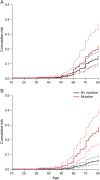Age-specific penetrance of LRRK2 G2019S in the Michael J. Fox Ashkenazi Jewish LRRK2 Consortium
- PMID: 26062626
- PMCID: PMC4501942
- DOI: 10.1212/WNL.0000000000001708
Age-specific penetrance of LRRK2 G2019S in the Michael J. Fox Ashkenazi Jewish LRRK2 Consortium
Abstract
Objective: Estimates of the penetrance of LRRK2 G2019S vary widely (24%-100%), reflective of differences in ascertainment, age, sex, ethnic group, and genetic and environmental modifiers.
Methods: The kin-cohort method was used to predict penetrance in 2,270 relatives of 474 Ashkenazi Jewish (AJ) Parkinson disease (PD) probands in the Michael J. Fox LRRK2 AJ Consortium in New York and Tel Aviv, Israel. Patients with PD were genotyped for the LRRK2 G2019S mutation and at least 7 founder GBA mutations. GBA mutation carriers were excluded. A validated family history interview, including age at onset of PD and current age or age at death for each first-degree relative, was administered. Neurologic examination and LRRK2 genotype of relatives were included when available.
Results: Risk of PD in relatives predicted to carry an LRRK2 G2019S mutation was 0.26 (95% confidence interval [CI] 0.18-0.36) to age 80 years, and was almost 3-fold higher than in relatives predicted to be noncarriers (hazard ratio [HR] 2.89, 95% CI 1.73-4.55, p < 0.001). The risk among predicted G2019S carrier male relatives (0.22, 95% CI 0.10-0.37) was similar to predicted carrier female relatives (0.29, 95% CI 0.18-0.40; HR male to female: 0.74, 95% CI 0.27-1.63, p = 0.44). In contrast, predicted noncarrier male relatives had a higher risk (0.15, 95% CI 0.11-0.20) than predicted noncarrier female relatives (0.07, 95% CI 0.04-0.10; HR male to female: 2.40, 95% CI 1.50-4.15, p < 0.001).
Conclusion: Penetrance of LRRK2 G2019S in AJ is only 26% and lower than reported in other ethnic groups. Further study of the genetic and environmental risk factors that influence G2019S penetrance is warranted.
© 2015 American Academy of Neurology.
Figures


References
-
- Paisan-Ruiz C, Jain S, Evans EW, et al. Cloning of the gene containing mutations that cause PARK8-linked Parkinson's disease. Neuron 2004;44:595–600. - PubMed
-
- Ozelius LJ, Senthil G, Saunders-Pullman R, et al. LRRK2 G2019S as a cause of Parkinson's disease in Ashkenazi Jews. N Engl J Med 2006;354:424–425. - PubMed
-
- Clark LN, Wang Y, Karlins E, et al. Frequency of LRRK2 mutations in early- and late-onset Parkinson disease. Neurology 2006;67:1786–1791. - PubMed
-
- Orr-Urtreger A, Shifrin C, Rozovski U, et al. The LRRK2 G2019S mutation in Ashkenazi Jews with Parkinson disease: is there a gender effect? Neurology 2007;69:1595–1602. - PubMed
